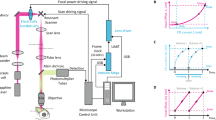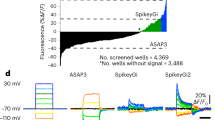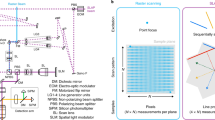Abstract
Two-photon–excited fluorescence laser-scanning microscopy (2PLSM) has provided a wealth of information about the spatiotemporal properties of biological processes at the single cell and population level. Because such nonlinear optical methods allow for imaging deep within biological tissue, 2PLSM can be combined with patch-clamp techniques to obtain electrophysiological recordings from specific fluorescently labeled cells in vivo. Here a protocol referred to as two-photon targeted patching (TPTP) describes a method that may be used to record from cells in the intact animal labeled by virtually any type of fluorophore. We target neurons that have been optically and genetically identified using green fluorescent protein (GFP) expressed under the control of a specific promoter. TPTP when combined with genetic approaches therefore permits electrophysiological recordings from specified neurons and their compartments, including dendrites. This technique may be repeated in the same preparation many times over the course of several hours and is equally applicable to non-neuronal cell types.
This is a preview of subscription content, access via your institution
Access options
Subscribe to this journal
Receive 12 print issues and online access
$259.00 per year
only $21.58 per issue
Buy this article
- Purchase on Springer Link
- Instant access to full article PDF
Prices may be subject to local taxes which are calculated during checkout




Similar content being viewed by others
References
Denk, W., Strickler, J.H. & Webb, W.W. Two-photon laser scanning fluorescence microscopy. Science 248, 73–76 (1990).
Theer, P., Hasan, M.T. & Denk, W. Two-photon imaging to a depth of 1000 μm in living brains by use of a Ti:Al2O3 regenerative amplifier. Opt. Lett. 28, 1022–1024 (2003).
Helmchen, F. & Denk, W. Deep tissue two-photon microscopy. Nat. Methods 2, 932–940 (2005).
Cahalan, M.D., Parker, I., Wei, S.H. & Miller, M.J. Real-time imaging of lymphocytes in vivo. Curr. Opin. Immunol. 15, 372–377 (2003).
Rubart, M. Two-photon microscopy of cells and tissue. Circ. Res. 95, 1154–1166 (2004).
Molitoris, B.A. & Sandoval, R.M. Intravital multiphoton microscopy of dynamic renal processes. Am. J. Physiol. Renal Physiol. 288, F1084–F1089 (2005).
Denk, W. & Svoboda, K. Photon upmanship: why multiphoton imaging is more than a gimmick. Neuron 18, 351–357 (1997).
Kleinfeld, D. & Griesbeck, O. From art to engineering? The rise of in vivo mammalian electrophysiology via genetically targeted labeling and nonlinear imaging. PLoS Biol. 3, e355 (2005).
Dittgen, T. et al. Lentivirus-based genetic manipulations of cortical neurons and their optical and electrophysiological monitoring in vivo. Proc. Natl. Acad. Sci. USA 101, 18206–18211 (2004).
Stosiek, C., Garaschuk, O., Holthoff, K. & Konnerth, A. In vivo two-photon calcium imaging of neuronal networks. Proc. Natl. Acad. Sci. USA 100, 7319–7324 (2003).
Nimmerjahn, A., Kirchhoff, F. & Helmchen, F. Resting microglial cells are highly dynamic surveillants of brain parenchyma in vivo. Science 308, 1314–1318 (2005).
Trachtenberg, J.T. et al. Long-term in vivo imaging of experience-dependent synaptic plasticity in adult cortex. Nature 420, 788–794 (2002).
Ohki, K., Chung, S., Ch'ng, Y.H., Kara, P. & Reid, R.C. Functional imaging with cellular resolution reveals precise micro-architecture in visual cortex. Nature 433, 597–603 (2005).
Hubener, M. & Bonhoeffer, T. Visual cortex: two-photon excitement. Curr. Biol. 15, R205–R208 (2005).
Holtmaat, A.J. et al. Transient and persistent dendritic spines in the neocortex in vivo. Neuron 45, 279–291 (2005).
Kerr, J.N., Greenberg, D. & Helmchen, F. Imaging input and output of neocortical networks in vivo. Proc. Natl. Acad. Sci. USA 102, 14063–14068 (2005).
Margrie, T.W., Brecht, M. & Sakmann, B. In vivo, low-resistance whole-cell recordings from neurons in the anaesthetized and awake mammalian brain. Pflugers Arch. 444, 491–498 (2002).
Svoboda, K., Denk, W., Kleinfeld, D. & Tank, D.W. In vivo dendritic calcium dynamics in neocortical pyramidal neurons. Nature 385, 161–165 (1997).
Svoboda, K., Helmchen, F., Denk, W. & Tank, D.W. Spread of dendritic excitation in layer 2/3 pyramidal neurons in rat barrel cortex in vivo. Nat. Neurosci. 2, 65–73 (1999).
Helmchen, F., Svoboda, K., Denk, W. & Tank, D.W. In vivo dendritic calcium dynamics in deep-layer cortical pyramidal neurons. Nat. Neurosci. 2, 989–996 (1999).
Waters, J., Larkum, M., Sakmann, B. & Helmchen, F. Supralinear Ca2+ influx into dendritic tufts of layer 2/3 neocortical pyramidal neurons in vitro and in vivo. J. Neurosci. 23, 8558–8567 (2003).
Margrie, T.W., Sakmann, B. & Urban, N.N. Action potential propagation in mitral cell lateral dendrites is decremental and controls recurrent and lateral inhibition in the mammalian olfactory bulb. Proc. Natl. Acad. Sci. USA 98, 319–324 (2001).
Margrie, T.W. et al. Targeted whole-cell recordings in the mammalian brain in vivo. Neuron 39, 911–918 (2003).
Callaway, E.M. A molecular and genetic arsenal for systems neuroscience. Trends Neurosci. 28, 196–201 (2005).
Schrader, M., Hofmann, U.G. & Hell, S.W. Ultrathin fluorescent layers for monitoring the axial resolution in confocal and two-photon fluorescence microscopy. J. Microsc. 191, 135–140 (1998).
Acknowledgements
The authors wish to thank P. Chadderton for his assistance in generating the figures and reading the manuscript and D. Farquarson for providing the design layout of the headplate. T.W.M. is supported by The Welcome Trust and The Human Frontiers Science Program (P.O. and T.W.M.).
Author information
Authors and Affiliations
Corresponding author
Ethics declarations
Competing interests
The authors declare no competing financial interests.
Rights and permissions
About this article
Cite this article
Komai, S., Denk, W., Osten, P. et al. Two-photon targeted patching (TPTP) in vivo. Nat Protoc 1, 647–652 (2006). https://doi.org/10.1038/nprot.2006.100
Published:
Issue Date:
DOI: https://doi.org/10.1038/nprot.2006.100
This article is cited by
-
Single-neuron representation of learned complex sounds in the auditory cortex
Nature Communications (2020)
-
Single-neuron perturbations reveal feature-specific competition in V1
Nature (2019)
-
Assembly and operation of the autopatcher for automated intracellular neural recording in vivo
Nature Protocols (2016)
-
Simultaneous all-optical manipulation and recording of neural circuit activity with cellular resolution in vivo
Nature Methods (2015)
-
Neuronal activity is not required for the initial formation and maturation of visual selectivity
Nature Neuroscience (2015)
Comments
By submitting a comment you agree to abide by our Terms and Community Guidelines. If you find something abusive or that does not comply with our terms or guidelines please flag it as inappropriate.



